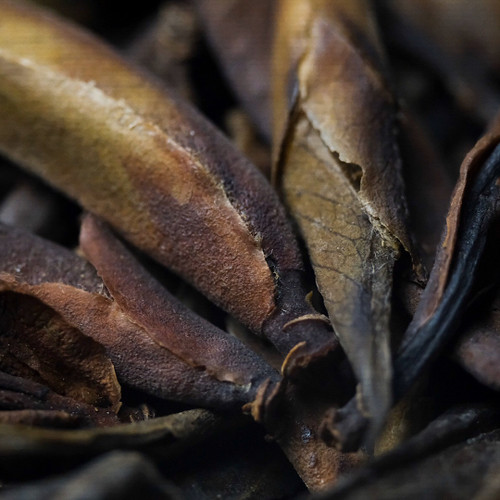Cooked Ya Bao (熟芽苞, Shóu Yá Bāo, "Cooked Bud") - Yá Bāo is the new growth of a species of plant that the farmers in Yunnan refer to as yě shēng chá 野生茶 ("wild tea"). These trees are distributed randomly throughout the forest, and were not planted by anybody, nor are they cultivated by anybody. At first glance, these trees are similar in appearance to gǔ shù 古樹 ("ancient tree") Pu'er tea trees, however the latter are often found planted in rows in old arbors. Unlike the domesticated Pu'er plant, the Yá Bāo plants send off their new growth in the middle of Winter, as opposed to Spring. The differences don't end there: whereas the buds of domesticated Pu'er plants will regenerate several days after being plucked throughout the growing season and will develop into one or two leaves upon reaching maturity, Yá Bāo only come out once per year and do not regrow after being plucked until the following year. When they mature, each bud develops into four or five leaves, which are often red, purple, or even white when they are young, turning green as they grow. Because each Yá Bāo is destined to become multiple leaves, their appearance is distinct from the single buds we associate with the domesticated tea plant. Instead, they appear as a sheaf of buds nested within each other, similar to bamboo shoots or hops. The fact that these wild trees grow far apart from each other, and often in remote or inaccessible places, combined with the low annual yield of each tree, has prevented Yá Bāo from being commercially viable, despite being prized by tea farmers and locals. These plants have recently been identified by science as a completely distinct species, Camelia crassicolumna, which may be a contributor to the gene pool of the modern domestic tea plant. Recent studies (Liu et. al., 2009) have found that crassicolumna contains neithter caffeine nor theophylline, the stimulant xanthines found in tea. It is considered, however, to be tea by tea farmers. Cooked Yá Bāo yeilds more of a blue-ish gray liquor than its raw counterpart, and whereas Raw Yá Bāo is sweet and floral, Cooked Yá Bāo has a deep, mineral bitterness that is seated in the back of the throat. In contrast to the floating, euphoric Qi of Raw Yá Bāo, the cooked version has a driving, linear somatic energy.


